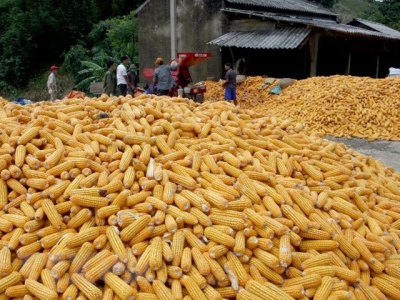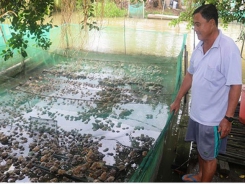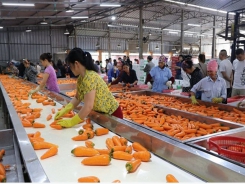Biotechnology contributes to higher productivity and increased incomes

HÀ NỘI — The adoption of biotechnology in corn production in Việt Nam had resulted in higher productivity, increased income and environmental improvement, attendees heard at a workshop held in Hà Nội on Wednesday.
A maize collection point in Sơn La Province. VNA/VNS Đình Huệ
The workshop was organised by the Việt Nam Seed Trade Association (VSTA), Việt Nam Farmers’ Union (VFU) and the International Service for the Acquisition of Agri-biotech Applications (ISAAA).
Speaking at the workshop, Trần Xuân Định, Vice Chairman and General Secretary of the Việt Nam Seed Trade Association, said that many plant varieties created using biotechnology are present in Việt Nam, facilitating plant and livestock restructuring and increased incomes thanks to better productivity and reduced pesticide costs.
In Việt Nam, biotech crops were officially approved for commercial corn farming from 2014-2015.
Corn is also one of the main crops in Việt Nam’s agricultural production structure and the country is among the largest corn producers in the world.
“The introduction of biotech varieties with improved traits into production at that time was considered one of the key tools to further increase production yield and quality, add value, and bring more profit to corn farmers, thereby strengthening Việt Nam's capability in supplying raw materials to the domestic food and feed supply chain,” Định said.
A study conducted in 2019-2020 by VSTA and the United Kingdom’s PG Economics on the impact of biotech corn after five years of cultivation showed that biotech corn with insect resistance and herbicide tolerance traits delivered between 15.2 and 30 per higher yields compared to conventional hybrid corn varieties. Farmers’ incomes increased by VNĐ4.5-7.6 million (US$196-330) per hectare.
Biotech corn cultivation also resulted in a significant decrease in pesticide use, with an average reduction of 26 per cent for herbicides and 78 per cent for insecticides (average amounts applied per hectare), corresponding to a reduction in the associated environmental impact, as measured by the Environmental Impact Quotient (EIQ) indicator of 36 and 77 per cent, respectively.
However, Định said, the biotech corn adoption rate has not met expectations.
By 2019, the total acreage of biotech corn was about 92,000 hectares, accounting for approximately 10 per cent of the country's total corn acreage.
Despite the increasing demand for corn in the livestock industry, the domestic corn acreage showed a downward trend over the past five years, he said.
“Domestic corn production is in fierce competition with imported corn in terms of price and quality; farmers in many regions have changed to plant other crops when profits from corn cultivation were not high, especially when the domestic purchasing prices plummeted.”
Participants at the workshop exchanged information on the status of agricultural biotechnology adoption in the world as well as in Việt Nam. They discussed the socio-economic impacts of biotech corn after five years of being approved for farming in Việt Nam.
Analysing the effects of biotech crops on a global scale, Graham Brookes of PG Economics cited the data in the latest study released in 2020: “In 2018, the total extra income for farmers cultivating biotech crops was US$19 billion - for each extra US dollar invested in biotech crop seeds, farmers could make an extra profit of US$4.42."
In addition, had biotech crops not been grown in 2018, an additional 23 billion kilos of carbon dioxide would have been emitted into the atmosphere, which is the equivalent of adding 15.3 million cars to the roads.
According to Brookes, farmers, especially small-hold farmers in developing countries, are those who benefit the most from biotech crops, not only from increased crop yields (from 10 to 16.5 per cent, depending on crop type) and higher profits (approximately US$103 per ha on average) but also from the change in farming habits to become more environmentally friendly when the amount of pesticides could be reduced.
Định said that in accordance with the Agricultural Biotechnology Development Project to 2023, one of the goals to be achieved by Việt Nam by 2030 is to master a number of new generation biotechnologies, create industrial-scale products for application to production practice, and increase the number of biotechnology enterprises in the agriculture, forestry and fishery sector by at least 30 per cent compared to the 2021-2025 period.
It meant that agricultural biotechnology development and adoption is a general development orientation of the country and Việt Nam needs to catch up with the world trend in applying new generation plant varieties towards sustainable and modern agriculture development.
In order to promote the development of biotechnology in agriculture, it was necessary to have a transparent direction and policy, with key investments of the State for units and enterprises which are pioneers in the application of biotechnology in the sector, Định said.
Có thể bạn quan tâm
Phần mềm

Phối trộn thức ăn chăn nuôi

Pha dung dịch thủy canh

Định mức cho tôm ăn

Phối trộn phân bón NPK

Xác định tỷ lệ tôm sống

Chuyển đổi đơn vị phân bón

Xác định công suất sục khí

Chuyển đổi đơn vị tôm

Tính diện tích nhà kính

Tính thể tích ao hồ




 Vietnam’s rice exports to Thailand enjoy sharp increase
Vietnam’s rice exports to Thailand enjoy sharp increase  Agriculture sector needs to develop raw materials to…
Agriculture sector needs to develop raw materials to…